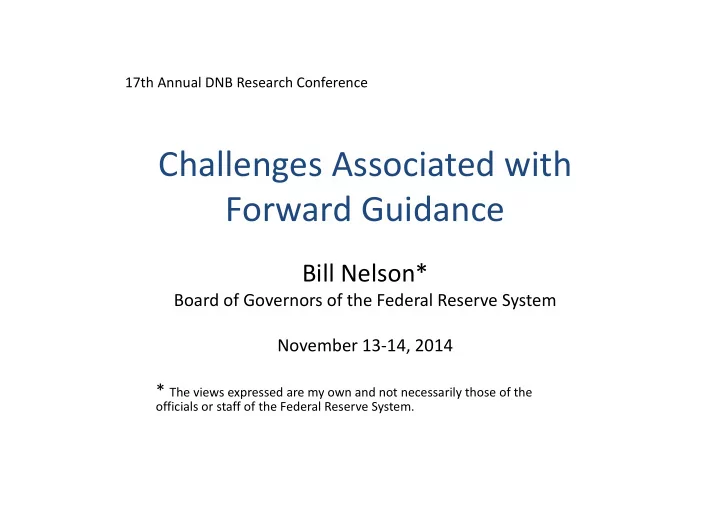

17th Annual DNB Research Conference Challenges Associated with Forward Guidance Bill Nelson* Board of Governors of the Federal Reserve System November 13 ‐ 14, 2014 * The views expressed are my own and not necessarily those of the officials or staff of the Federal Reserve System.
What is Forward Guidance? • A conditional statement by the central bank about its future intentions for monetary policy • Between a forecast of policy and a commitment – Regularly produced forecasts are revised up or down freely – Commitments tend to be unconditional and reneging on them would likely reduce a central bank’s credibility significantly 2
Objectives of Forward Guidance • Increased transparency – Provide information about the central bank’s policy preferences and outlook – Or simply reflects a one ‐ off agreement on characteristics of the path for policy. • Provide stimulus (in recent years) – Indicate to market participants that policy will be more accommodative in the future than had been expected – Or increase market confidence about the likely path of policy rates, reducing term premiums – Or reduce the likelihood that market expectations will shift toward tighter policy in the future 3
Recent FOMC Forward Guidance • Since December 2008, with the fed funds target at its effective lower bound, the FOMC has used several different types of forward guidance – Qualitative guidance (the federal funds rate is likely to be near zero for “an extended period”) – Date ‐ based guidance (“at least through mid ‐ 2013”) – Threshold ‐ based guidance (“at least as long as the unemployment rate is above 6½ percent and projected inflation is below 2½ percent”) – Mix: “Considerable time after the end of asset purchases.” • Separately, the FOMC began publishing participants’ projections for the federal funds rate in January 2012 4
Challenges Associated with Forward Guidance There is a Catch ‐ 22 associated with forward guidance • – For the most part, forward guidance provides stimulus by convincing market participants that policy rates will be lower for longer than they had previously anticipated – At the same time, the central bank likely wants there to be only a small chance that it will want to tighten policy earlier than implied by the forward guidance – There may be no guidance that accomplishes both objectives, except when the market significantly underestimates the central bank’s intentions to provide accommodation The outlook for policy after the guidance period has a big impact on • longer ‐ term rates and so on aggregate demand – If the guidance does not change the public’s understanding of the Committee’s preferences, then any promise to be easier for a while will be undone by an expectation to be tighter subsequently 5
Challenges Associated with Forward Guidance ( cont’d) • Difficult to avoid the misimpression that date ‐ based or even qualitative guidance is a commitment – The switch from date ‐ based to threshold ‐ based guidance clarified the conditionality of the Committee’s guidance while still providing accommodation • Lengthening the guidance period can damage confidence in the economic outlook “economic conditions are likely to warrant [a funds rate near zero] at least through…” “…will remain appropriate for a considerable time after the economic recovery strengthens. In particular…” 6
Challenges Associated with Forward Guidance (cont’d) • It has been difficult at times to explain the differences between the fed funds forecasts in the SEP and the forward guidance – The forward guidance conveys the consensus view of the Committee. – In January 2012, “…at least through late 2014” but the SEP showed: 7
Forward Guidance about LSAPS: • Flow ‐ based asset purchase program required the Committee to provide guidance about future purchases – “…at least until the outlook for labor market conditions has improved substantially, subject to an ongoing review of efficacy and costs” – After tapering began: • “If incoming information broadly supports the Committee’s expectation of ongoing improvement in labor market conditions and inflation moving back toward its longer ‐ run objective, the Committee will likely reduce the pace of asset purchases in further measured steps at future meetings” 8
Challenges associated with communicating about LSAPs • Moessner and Nelson (2008) found that market participants don’t take guidance incorrectly as a commitment, don’t overreact. • Taper tantrum (and earlier drop in rates) calls that conclusion into question. • The sharp reaction may have reflected the difficulty of predicting the total amount purchased under the program. 9
Challenges associated with communicating about LSAPs (cont’d) • The taper tantrum also illustrates a challenge associated with providing guidance about two different policy tools – The expected path for the federal funds rate moved up in May ‐ June when market participants adjusted down their outlook for asset purchases 10
17th Annual DNB Research Conference Challenges Associated with Forward Guidance Bill Nelson* Board of Governors of the Federal Reserve System November 13 ‐ 14, 2014 * The views expressed are my own and not necessarily those of the officials or staff of the Federal Reserve System.
Recommend
More recommend